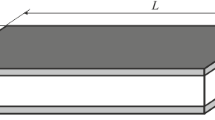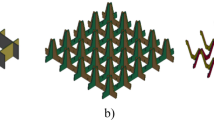The analysis of stiffness degradation and the identification of damage mechanisms during and after fatigue tests of sandwich panels with PVC foam cores have been performed. The sandwich panels with cross-ply laminates skins made of glass fiber and epoxy resin were manufactured by vacuum moulding and subjected to three-point bending tests. Two PVC cores of similar type but with differing densities were investigated. The effect of core density and thickness on the damage behavior was highlighted. Using the cyclic life criterion, fatigue curves were plotted according to two models and compared with those of the literature. It has been demonstrated that the sandwich SD 2, with the higher core density, withstands a higher load and possesses greater rigidity in static tests, combined with an enhanced fatigue resistance, when compared to sandwich SD 1 which has a lower core density.
Similar content being viewed by others
References
A. Bezazi, A. El Mahi, J.-M. Berthelot, and B. Bezzazi, “Experimental analysis of behavior and damage of sandwich composite materials in three-point bending. Part 1. Static tests and stiffness degradation at failure studies,” Strength Mater., 39, No. 2, 170–177 (2007).
N. Kulkarni, H. Mahfuz, S. Jeelani, and L. A. Carlsson, “Fatigue crack growth and life prediction of foam core sandwich composites under flexural loading,” Compos. Struct., 59, 499–505 (2003).
A. El Mahi, M. Khawar Farooq, S. Sahraoui, and A. Bezazi, “Modelling the flexural behavior of sandwich composite materials under cyclic fatigue,” Mater. Design, 25, 199–208 (2004).
V. M. Harik, J. R. Klinger, and T. A. Bogetti, “Low-cycle fatigue of unidirectional composites: Bilinear S–N curves,” Int. J. Fatigue, 24, 455–462 (2002).
M. Salvia, L. Fiore, P. Fournier, and L. Vincent, “Flexural fatigue behavior of UDGFRP experimental approach,” Int. J. Fatigue, 9, No. 3, 253–262 (1997).
S. Tamboura, H. Sidhom, et H. P. Lieurade, “Matériau composite à fibre de carbone et matrice époxyde: étude du mécanisme d’endommagement,” Matériau et Techniques, No. 3–4, 15–20 (1996).
L. Fiore, Contribution à l’Étude du Comportement en Fatigue de Matériaux Composite à Renfort Verre Unidirectionnel, Thèse de l’Ecole Centrale de Lyon (1988).
E. Vauthier, Durabilité et Vieillissement Hygrothermique de Composites Verre/Époxyde Soumis à des Sollicitations de Fatigue, Thèse de l’Ecole Centrale de Lyon (1996).
F. Roudet, Comportement en Flexion Trois Points avec Cisaillement Prépondérant de Composites Verre/Époxyde Unidirectionnels: sous Chargement Monotones et Cyclique, Thèse de Doctorat de l’Université des Sciences et Technologie de Lile (1998)
A. R. Bezazi, A. El Mahi, J.-M. Berthelot, and B. Bezzazi, “Flexural fatigue behavior of cross-ply laminates: An experimental approach,” Strength Mater., 35, No. 2, 149–161 (2003).
A. R. Bezazi, A. El Mahi, J.-M. Berthelot, and A. Kondratas, “Investigation of cross-ply laminates behaviour in three point bending tests. Pt. II: Cyclic fatigue tests,” Mater. Sci., 9, No. 1, 128–133 (2003).
A. R. Bezazi, A. El Mahi, J.-M. Berthelot, and B. Bezzazi, “Influence of reinforcement in cross-ply laminates in flexural testing,” in: New Trends in Fatigue and Fracture (Congr., Apr. 8–9, 2002).
A. R. Bezazi, A. El Mahi, J.-M. Berthelot, and B. Bezzazi, “Analyse du comportement et de l’endommagement des matériaux composites sandwiches en flexion 3-points,” 16ème Congrès Français de Mécanique (Nice, 1–5 Septembre 2003).
J. F. Mandell, “Fatigue behavior of fibre resin composites,” in: P. G. Pritchard (Ed.), Developments in Reinforced Plastics, Applied Science Publ., London; New York (1982), pp. 67–107.
G. D. Sims and D. G. Gladman, “A framework for specifying the fatigue performance of glass fibre reinforced plastics,” in: NPL Report DMA (a) 59 (1982), pp. 1–24.
P. Fournier, Comportement sous Sollicitation Cyclique des Composites Unidirectionnels Verre/Époxy. Cas des Résines à Ténacité Améliorée, Thèse de l’Ecole Centrale de Lyon (1992).
P. T. Curtis, “Tensile fatigue mechanisms in unidirectional polymer matrix composite materials,” Int. J. Fatigue, 13, No. 5, 377–382 (1991).
B. Haris, H. Reiter, T. Adam, et al., “Fatigue behavior of carbon fibre reinforced plastics,” Composites, 21, No. 3 (1990).
L. Lorenzo and H. T. Hahn, “Fatigue failure mechanisms in unidirectional composites,” in: H. T. Hahn, (Ed.), Composite Materials: Fatigue, ASTM STP 907, Philadelphia (1986), pp. 210–232.
H. Harel, J. Aronhime, K. Schulte, et al., “Rate dependent fatigue of aramid- fibre/carbon-fibre hybrids,” J. Mater. Sci., 25, 1313–1317 (1990).
G. Caprino and G. Giorleo, “Fatigue lifetime of glass fibre/epoxy composites,” J. Compos., Part A: Appl. Sci. Manufact., 30, 299–304 (1999).
S. D. Clark, Long Term Behavior of FRP Structural Foam Cored Sandwich Beams, Ph.D Thesis, University of Southampton, UK (1997).
Author information
Authors and Affiliations
Additional information
Translated from Problemy Prochnosti, No. 3, pp. 32–44, May–June, 2009.
Rights and permissions
About this article
Cite this article
Bezazi, A., El Mahi, A., Berthelot, JM. et al. Experimental analysis of behavior and damage of sandwich composite materials in three-point bending. Part 2. Fatigue test results and damage mechanisms. Strength Mater 41, 257–267 (2009). https://doi.org/10.1007/s11223-009-9131-6
Received:
Published:
Issue Date:
DOI: https://doi.org/10.1007/s11223-009-9131-6




